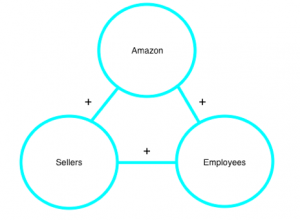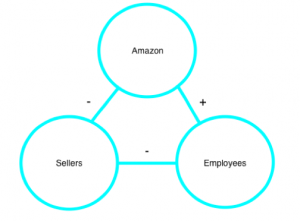Surprisingly Stable Relationships between Amazon, Employees, and Sellers
Most people know that the global online retail giant Amazon has created a strong community of sellers and employees to deliver high-quality products quickly and efficiently. The relationships between Amazon, Employees, and Sellers consist of only positive connections since Sellers and Employees rely on Amazon to survive while Amazon needs them to produce revenue. The set of connections can be represented by the figure below and follows the Structural Balance Property as expected.
Figure 1: Beneficial relations within the Amazon Community
The model above is by far the most beneficial set up where all 3 groups benefit, but it is not the only set of relations within the Amazon B-B community. Among sellers, there is a subset of people who use fake reviews and product scams to produce even more capital at the expensive of Amazon’s reputation and expected high-quality service. These falsities are a huge problem for Amazon and its employees, so it is unsurprising that the company has taken a priority to phish out these scams. Employees get paid by Amazon to seek out these sellers causing the employees and Amazon to maintain a beneficial relationship between each other. Since Employees’ benefits are directly influenced by Amazon’s reputation and success, employees also dislike sellers who abuse Amazon’s rating system for their own benefit. The set of connections can be represented by the figure below which also follows the structural balance property.
Figure 2: Negative relations between Amazon/Employees and Sellers within the Amazon Community
These are not the only profitable negative relationship for sellers. Recently, Amazon has had to investigate its own employees who accept bribes from the scamming sellers to supplement their low pay. They trade everything from data and analytics on the company to illegally reinstating or helping scam accounts. This comes at the cost of Amazon’s reputation once again and only benefits the sellers and Employees who are making extra Capital. The sellers involved in these operations gain a significant advantage over others selling the same product. The figure below which also satisfies the structural balance property represents these relations.
Figure 3: Negative relations between Amazon and Sellers/Employees within the Amazon Community.
While these 3 sets of relations between the 3 groups of people are simple and generalized, they reveal an important aspect of maintaining a community. Amazon expects the mutually beneficial relationships from its community, but this best-case scenario is not the only set of relations that exist. In fact, the majority of the possible triangular relations that satisfy the Structural Balance property also exist. If Amazon had looked at all the possible relationships in their community at an earlier stage, they could have created a “game” that better favors the mutually benefitted relationships that Amazon intends to create. For example, a pay raise and better company benefits could drastically reduce the set of relations in Figure 3 (which are the most problematic as not having trustworthy employees can lead to major crisis’s as a company grows) as the cost for participating in such a relation would outweigh the benefits of that relationship. Amazons case can be seen of as an example where community problems can be predicted and prevented with a combination of graph theory and game theory.



